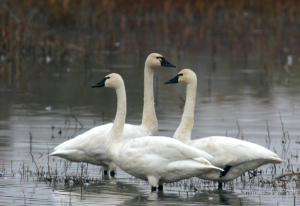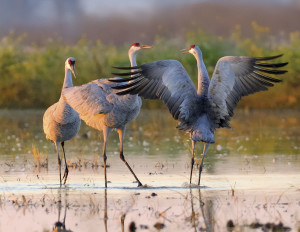It’s a short trip east to Lodi to see the sandhill cranes. Each autumn the birds return, several thousand of them, to overwinter in the Central Valley. They’re a rare treat worth the pilgrimage. Sandhills are one of only 15 species of crane in the world, and of these only whooping cranes also inhabit North America. Fossils dating back 6 million years make sandhills the oldest known species of bird still living.
The sandhills’ dramatic appearance seems fitting for such ancient avians. Large and a little bit gangly, with long bills, long legs, and long necks, they’re most distinguished by their bright red crowns. Given their appearance, you can imagine what a spectacle these birds make when they begin their characteristic courtship dance. In pairs (the birds mate for life), they move about, bowing and hopping with exuberance, arching their necks and sometimes lifting their bills to call out in unison.
In the first weekend of November, by way of welcome, the Lodi Chamber of Commerce hosts the Sandhill Crane Festival, complete with lectures, crane-inspired poetry, and guided tours of the Isenberg Crane Reserve. This is not the only time to spot the cranes, though. From October through the end of February, the Department of Fish and Game offers tours at the Reserve. You can also drive to the nearby Cosumnes River Preserve–host to as many as 4,000 cranes each winter–or west, down Woodbridge Road, to spy the delicate birds dancing and feasting on rice, corn stubble, and small animals in the farm fields.
The cranes begin to depart in late February, bound for their breeding grounds in Canada, Alaska and Siberia, though some remain as late as April.

.jpg)



